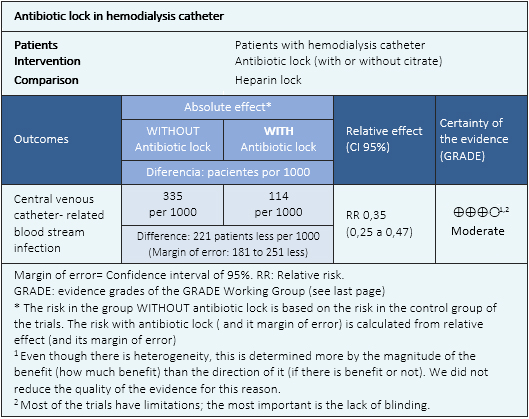Resúmenes Epistemonikos
← vista completaPublicado el 23 de enero de 2015 | http://doi.org/10.5867/medwave.2015.01.6069
¿Son efectivas las soluciones de sellado con antibiótico para prevenir la bacteriemia asociada a catéter de hemodiálisis?
Does antibiotic lock therapy prevent catheter-associated bacteremia in hemodialysis?
Abstract
Central venous catheter-related blood stream infection is a major cause of morbidity and mortality in patients with renal disease treated with hemodialysis. Antibiotic lock solutions can be effective in preventing this complication in patients with hemodialysis. Searching in Epistemonikos database, which is maintained by screening more than twenty databases, we identified eight systematic reviews including seventeen randomized trials. We combined the evidence using meta-analysis and generated a summary of findings table following the GRADE approach. We concluded that antibiotic lock solutions probably decrease catheter-related blood stream infection in hemodialysis patients.
Problem
Central venous catheter-related blood stream infections can lead to serious infectious complications in patients with renal disease treated with hemodialysis, such as infective endocarditis, septic pulmonary emboli, osteomyelitis and abscesses as a result of hematogenous seeding.
Despite the risks associated to this type of vascular access, many times it is the only option because of temporary loss of permanent hemodialysis access, peripheral vascular disease or as transitory alternative while waiting for the maturation of arteriovenous fistula. Intraluminal antibiotic lock solutions that are maintained for a specified time before being removed can be useful for decreasing the risk of central venous catheter-related blood stream infections.
Methods
We used Epistemonikos database, which is maintained by screening more than 20 databases, to identify systematic reviews and their included primary studies.
With this information we generated a structured summary using a pre-established format, which includes key messages, a summary of the body of evidence (presented as an evidence matrix in Epistemonikos), meta-analysis of the total of studies, a summary of findings table following the GRADE approach and a table of other considerations for decision-making.
|
Key messages
|
About the body of evidence for this question
|
What is the evidence |
We found 8 systematic reviews [1],[2],[3],[4],[5],[6],[7],[8] |
|
What types of patients were included |
The trials included patients with no distinction by sex or age. All of the trials included hemodialysis patients, using tunneled (11 trials), non-tunneled (4 trials) or both types of catheters (2 trials). The randomized trials included 1921 adult patients. |
|
What types of interventions were included |
The studies employed different kind of antibiotics as lock therapy (vancomycin, gentamicin, minocicline, cefotaxime, cefazoline and linezolid; associated to heparin, tricitasol, citrate or etildiaminotetraacetic acid). All trials compared against heparin in the control group. |
|
What types of outcomes were measured |
Bacteremia/ central venous catheter-related blood stream infection, time until infection, exit-site infection, catheter-associated mortality, total mortality. |
Summary of findings
This information is based on 17 randomized trials. All of them reported central venous catheter-related blood stream infection.
- Antibiotic lock solutions probably decrease catheter-related blood stream infection in hemodialysis patients.

Other considerations for decision-making
|
To whom this evidence does and does not apply |
|
| About the outcomes included in this summary |
|
|
Balance between benefits and risks, and certainty of the evidence |
|
| What do patients and their doctors think about |
|
|
Resource considerations |
|
|
Feasibility and implementation |
|
|
Differences between this summary and other sources |
|
|
Could this evidence change in the future? |
|
How we conducted this summary
Using automated and collaborative means we compiled all the relevant evidence for the question of interest and we present a matrix of evidence
 Full size
Full size Follow the link to access the interactive version: Antibiotic lock therapy for prevention of central venous catheter-related blood stream infection in hemodialysis

Notes
The upper portion of the matrix of evidence will display a warning of “new evidence” if new systematic reviews are published after the publication of this summary.
Even though the project considers the periodical update of these summaries, users are invited to comment in the website of Medwave or to contact the authors through email if they realize there is new evidence and the summary should be updated earlier.
After creating an account in Epistemonikos, users will be able to save the matrixes and to receive automated notifications any time new evidence potentially relevant for the question appears.
The details about the methods used to produce this summaries are described here http://dx.doi.org/10.5867/medwave.2014.06.5997.
Epistemonikos foundation is a non-for-profit organisation aiming to bring information closer to those making health decisions, through the use of technology. Its main development is Epistemonikos database (www.epistemonikos.org).
These summaries follow a rigorous process of internal peer review.
Follow the link to access the interactive version Antibiotic lock therapy for prevention of central venous catheter-related blood stream infection in hemodialysis

